Designing for Dyads: A Comparative User Experience Study of Remote and Face-to-Face Multi-User Interfaces
Abstract
1. Introduction
2. Materials and Methods
2.1. Apparatus and Game Interface
2.2. Participant Recruitment and Informed Consent
2.3. Physical Setting and Experimental Arrangement
2.4. Procedure and Condition Order
2.5. Questionnaire Source
3. Results
3.1. Questionnaire Results
3.1.1. Scenarios
3.1.2. Results from Questions with Significant Scenario Effects
3.1.3. Results from Questions Without Significant Scenario Effects
3.2. Qualitative Findings from Post-Experiment Interviews
- The F2F-OneS condition promoted the strongest sense of interaction and social presence. Many participants stated that “interaction was most intense when sharing a screen face-to-face” and “physical proximity increased tension and involvement”.
- The remote condition heightened competitiveness and self-talk. Some noted the following: “I felt more pressure in the remote condition, my desire to win was stronger” and “playing apart led to more self-directed talk”.
- Attention and strategy were influenced by the interface setup. Participants reported more focus on the opponent’s paddle and ball in both the dual-screen and same-screen conditions, while physical cues (such as seeing the partner’s hands) only affected same-screen play.
- Verbal communication and emotional expression were shaped by partner closeness and gender pairing. A few mentioned the following: “if the partner is of the opposite sex, I would restrain my words” and “the more intimate, the more freely we talked”.
- Visual crowding and distraction were mentioned in the same-screen conditions. Some felt that “the screen felt crowded when both hands were present”, especially in same-screen play.
- With respect to game novelty and strategic discussion, the participants enjoyed sharing strategies, especially in face-to-face settings, but novelty decreased with repeated play.
4. Discussion
4.1. Questionnaire Analysis
4.2. Questions Without Significant Scenario Effects
4.3. Interview Findings
4.4. Limitations and Future Possibilities
5. Conclusions
Author Contributions
Funding
Institutional Review Board Statement
Informed Consent Statement
Data Availability Statement
Conflicts of Interest
References
- Stewart, J.; Bederson, B.B.; Druin, A. Single Display Groupware: A Model for Co-Present Collaboration. In Proceedings of the SIGCHI Conference on Human Factors in Computing Systems the CHI Is the Limit—CHI ’99, Pittsburgh, PA, USA, 15–20 May 1999; ACM Press: Pittsburgh, PA, USA, 1999; pp. 286–293. [Google Scholar]
- Hornecker, E.; Buur, J. Getting a Grip on Tangible Interaction: A Framework on Physical Space and Social Interaction. In Proceedings of the SIGCHI Conference on Human Factors in Computing Systems, Montréal, QC, Canada, 22–27 April 2006; Association for Computing Machinery: New York, NY, USA, 2006; pp. 437–446. [Google Scholar]
- Short, J.; Williams, E.; Christie, B. The Social Psychology of Telecommunications; Wiley: Hoboken, NJ, USA, 1976; ISBN 0-471-01581-4. [Google Scholar]
- Kreijns, K.; Xu, K.; Weidlich, J. Social Presence: Conceptualization and Measurement. Educ. Psychol. Rev. 2022, 34, 139–170. [Google Scholar] [CrossRef] [PubMed]
- Schmidt, K. Some Notes on Mutual Awareness; COTCOS CTI DTU: Copenhagen, Denmark, 1998; pp. 1–10. [Google Scholar]
- Shu, Y.; Furuta, K. An Inference Method of Team Situation Awareness Based on Mutual Awareness. Cogn. Technol. Work 2005, 7, 272–287. [Google Scholar] [CrossRef]
- Herrando, C.; Constantinides, E. Emotional Contagion: A Brief Overview and Future Directions. Front. Psychol. 2021, 12, 712606. [Google Scholar] [CrossRef] [PubMed]
- Hatfield, E.; Cacioppo, J.T.; Rapson, R.L. Emotional Contagion. Curr. Dir. Psychol. Sci. 1993, 2, 96–99. [Google Scholar] [CrossRef]
- Arroyo, E.; Righi, V.; Tarrago, R.; Santos, P.; Davinia, H.-L.; Blat, J. Remote Collaborative Multi-User Informal Learning Experiences: Design and Evaluation. In Proceedings of the 6th European Conference on Technology Enhanced Learning, EC-TEL 2011, Palermo, Italy, 20–23 September 2011; Volume 6964, p. 56, ISBN 978-3-642-23984-7. [Google Scholar]
- Park, S.; Gebhardt, C.; Rädle, R.; Feit, A.M.; Vrzakova, H.; Dayama, N.R.; Yeo, H.-S.; Klokmose, C.N.; Quigley, A.; Oulasvirta, A. Adam: Adapting multi-user interfaces for collaborative environments in real-time. In Proceedings of the 2018 CHI Conference on Human Factors in Computing Systems, Montréal, QC, Canada, 21–26 April 2018; pp. 1–14. [Google Scholar]
- Yuill, N.; Rogers, Y. Mechanisms for collaboration: A design and evaluation framework for multi-user interfaces. ACM Trans. Comput.-Hum. Interact. 2012, 19, 1–25. [Google Scholar] [CrossRef]
- Zhang, Z.; Peng, W.; Chen, X.; Cao, L.; Li, T.J.-J. LADICA: A Large Shared Display Interface for Generative AI Cognitive Assistance in Co-Located Team Collaboration. In Proceedings of the 2025 CHI Conference on Human Factors in Computing Systems, Yokohama, Japan, 26 April–1 May 2025; Association for Computing Machinery: New York, NY, USA, 2025; pp. 1–22. [Google Scholar]
- Schneider, J.; Derboven, J.; Luyten, K.; Vleugels, C.; Bannier, S.; De Roeck, D.; Verstraete, M. Multi-User Multi-Touch Setups for Collaborative Learning in an Educational Setting. In Proceedings of the 7th International Conference on Cooperative Design, Visualization, and Engineering, Calvia, Mallorca, Spain, 19–22 September 2010; Springer: Berlin/Heidelberg, Germany, 2010; pp. 181–188. [Google Scholar]
- Somandepalli, K.; Siy, O.; Jou, B. Relational Affect in Dyadic Interactions. In Proceedings of the Extended Abstracts of the CHI Conference on Human Factors in Computing Systems, Honolulu, HI, USA, 11–16 May 2024; Association for Computing Machinery: New York, NY, USA, 2024; pp. 1–9. [Google Scholar]
- Heryanto; Firmansyah, F.H.; Rosmansyah, Y. Exploring Collaboration in Multiplayer Gamification: A Systematic Literature Review. IEEE Access 2024, 12, 149399–149431. [Google Scholar] [CrossRef]
- Isabwe, G.M.N.; Schulz, R.; Reichert, F.; Konnestad, M. Using Multi-Touch Multi-User Interactive Walls for Collaborative Active Learning. In Proceedings of the HCI International 2019—Late Breaking Posters, Orlando, FL, USA, 26–31 July 2019; Stephanidis, C., Antona, M., Eds.; Springer International Publishing: Cham, Switzerland, 2019; pp. 192–199. [Google Scholar]
- Creed, C.; Sivell, J.; Sear, J. Multi-Touch Tables for Exploring Heritage Content in Public Spaces. In Visual Heritage in the Digital Age; Ch’ng, E., Gaffney, V., Chapman, H., Eds.; Springer Series on Cultural Computing; Springer London: London, UK, 2013; pp. 67–90. ISBN 978-1-4471-5534-8. [Google Scholar]
- Eriksson, E.; Petersen, J.O.; Bagge, R.; Kristensen, J.B.; Lervig, M.; Torgersson, O.; Baykal, G.E. Quadropong—Conditions for Mediating Collaborative Interaction in a Co-Located Collaborative Digital Game Using Multi-Display Composition. In Proceedings of the Adjunct Proceedings of the 2022 Nordic Human-Computer Interaction Conference, Aarhus, Denmark, 8–12 October 2022; Association for Computing Machinery: New York, NY, USA, 2022; pp. 1–2. [Google Scholar]
- Huang, Y.; Wang, Y.; Xiao, T.; Bei, R.; Zhao, Y.; Lu, Z.; Tong, X. StarRescue: Transforming A Pong Game to Visually Convey the Concept of Turn-Taking to Children with Autism. In Proceedings of the Extended Abstracts of the 2022 Annual Symposium on Computer-Human Interaction in Play, Bremen, Germany, 2–5 November 2022; Association for Computing Machinery: New York, NY, USA, 2022; pp. 246–252. [Google Scholar]
- Salas, J.; Vera, P.; Hernández, A.; Meza-de-Luna, M.-E. An Augmented Reality Implementation of the Pong Game. IEEE Trans. Games 2021, 13, 216–227. [Google Scholar] [CrossRef]
- Zagermann, J.; Pfeil, U.; Rädle, R.; Jetter, H.-C.; Klokmose, C.; Reiterer, H. When Tablets Meet Tabletops: The Effect of Tabletop Size on Around-the-Table Collaboration with Personal Tablets. In Proceedings of the 2016 CHI Conference on Human Factors in Computing Systems, San Jose, CA, USA, 7–12 May 2016; Association for Computing Machinery: New York, NY, USA, 2016; pp. 5470–5481. [Google Scholar]
- Hinrichs, U.; Carpendale, S. Gestures in the Wild: Studying Multi-Touch Gesture Sequences on Interactive Tabletop Exhibits. In Proceedings of the SIGCHI Conference on Human Factors in Computing Systems, Vancouver, BC, Canada, 7–12 May 2011; Association for Computing Machinery: New York, NY, USA, 2011; pp. 3023–3032. [Google Scholar]
- Ifenthaler, D.; Schweinbenz, V. The Acceptance of Tablet-PCs in Classroom Instruction: The Teachers’ Perspectives. Comput. Hum. Behav. 2013, 29, 525–534. [Google Scholar] [CrossRef]
- Dillenbourg, P.; Evans, M. Interactive Tabletops in Education. Int. J. Comput.-Support. Collab. Learn. 2011, 6, 491–514. [Google Scholar] [CrossRef]
- IJsselsteijn, W.A.; de Kort, Y.; Poels, K.; Jurgelionis, A.; Bellotti, F. Characterising and Measuring User Experiences in Digital Games. In Proceedings of the ACE2007: International Conference on Advances in Computer Entertainment Technology, Salzburg, Austria, 13–15 June 2007; pp. 1–4. [Google Scholar]
- Mahmoud, R.; Ben Aissa, M.; Tannoubi, A.; Saidane, M.; Guelmemi, N.; Puce, L.; Chen, W.; Chalghaf, N.; Azaiez, F.; Makram, Z.; et al. The Game Experience Questionnaire: Reliability and validity of the Web-based Revised Arabic Version (Preprint). JMIR Form. Res. 2022, 7, e42584. [Google Scholar] [CrossRef]
- Abeele, V.V.; Spiel, K.; Nacke, L.; Johnson, D.; Gerling, K. Development and Validation of the Player Experience Inventory: A Scale to Measure Player Experiences at the Level of Functional and Psychosocial Consequences. Int. J. Hum.-Comput. Stud. 2020, 135, 102370. [Google Scholar] [CrossRef]
- O’Brien, H.L.; Cairns, P.; Hall, M. A Practical Approach to Measuring User Engagement with the Refined User Engagement Scale (UES) and New UES Short Form. Int. J. Hum.-Comput. Stud. 2018, 112, 28–39. [Google Scholar] [CrossRef]
- Law, E.L.-C.; van Schaik, P.; Roto, V. Attitudes towards User Experience (UX) Measurement. Int. J. Hum.-Comput. Stud. 2014, 72, 526–541. [Google Scholar] [CrossRef]
- Hudson, M.; Cairns, P. 6 Measuring Social Presence in Team-Based Digital Games. In Interacting with Presence: HCI and the Sense of Presence in Computer-Mediated Environments; Walter de Gruyter: Berlin, Germany, 2014; pp. 83–101. [Google Scholar] [CrossRef]
- Kandemir, H.; Kose, H. Development of Adaptive Human–Computer Interaction Games to Evaluate Attention. Robotica 2022, 40, 56–76. [Google Scholar] [CrossRef]
- Tang, A.; Neustaedter, C.; Greenberg, S. VideoArms: Embodiments for Mixed Presence Groupware. In People and Computers XX—Engage; Bryan-Kinns, N., Blanford, A., Curzon, P., Nigay, L., Eds.; Springer: London, UK, 2007; pp. 85–102. [Google Scholar]
- Zhou, M.; Li, M.; Ono, K.; Watanabe, M. A Comparative Study of the User Interaction Behavior and Experience in a Home-Oriented Multi-User Interface (MUI) During Family Collaborative Cooking. Future Internet 2024, 16, 478. [Google Scholar] [CrossRef]
- Jansz, J.; Martens, L. Gaming at a LAN Event: The Social Context of Playing Video Games. New Media Soc. 2005, 7, 333–355. [Google Scholar] [CrossRef]
- Buisine, S.; Besacier, G.; Aoussat, A.; Vernier, F. How Do Interactive Tabletop Systems Influence Collaboration? Comput. Hum. Behav. 2012, 28, 49–59. [Google Scholar] [CrossRef]
- Voida, A.; Carpendale, S.; Greenberg, S. The Individual and the Group in Console Gaming. In Proceedings of the 2010 ACM Conference on Computer Supported Cooperative Work, Savannah, GA, USA, 6–10 February 2010; Association for Computing Machinery: New York, NY, USA, 2010; pp. 371–380. [Google Scholar]
- Mueller, F.; Gibbs, M.R.; Vetere, F.; Edge, D. Designing for Bodily Interplay in Social Exertion Games. ACM Trans. Comput.-Hum. Interact. 2017, 24, 24. [Google Scholar] [CrossRef]
- De Kort, Y.A.W.; Ijsselsteijn, W.A. People, Places, and Play: Player Experience in a Socio-Spatial Context. Comput. Entertain. 2008, 6, 18. [Google Scholar] [CrossRef]
- Ducheneaut, N.; Yee, N.; Nickell, E.; Moore, R.J. “Alone together?”: Exploring the Social Dynamics of Massively Multiplayer Online Games. In Proceedings of the SIGCHI Conference on Human Factors in Computing Systems, Montréal, QC, Canada, 22–27 April 2006; Association for Computing Machinery: New York, NY, USA, 2006; pp. 407–416. [Google Scholar]
- Nacke, L.; Drachen, A.; Göbel, S.; Darmstadt, T. Methods for Evaluating Gameplay Experience in a Serious Gaming Context. Int. J. Comput. Sci. Sport 2010, 9, 1–12. [Google Scholar]
- Haidusek-Niazy, S.; Huyler, D.; Carpenter, R.E. Mentorship Reconsidered: A Case Study of K-12 Teachers’ Mentor-Mentee Relationships during the COVID-19 Pandemic. Soc. Psychol. Educ. 2023, 26, 1269–1288. [Google Scholar] [CrossRef] [PubMed]
- Mainardi, I. Change management: Artificial Intelligence (AI) at the Service of Public Administrations. AI Soc. 2025, 40, 3953–3981. [Google Scholar] [CrossRef]
- Gergle, D.; Kraut, R.E.; Fussell, S.R. Using Visual Information for Grounding and Awareness in Collaborative Tasks. Hum.–Comput. Interact. 2013, 28, 1–39. [Google Scholar]
- Jaidka, K.; Ahuja, H.; Ng, L.H.X. It Takes Two to Negotiate: Modeling Social Exchange in Online Multiplayer Games. Proc. ACM Hum.-Comput. Interact. 2024, 8, 85. [Google Scholar] [CrossRef]
- Wisiecka, K.; Konishi, Y.; Krejtz, K.; Zolfaghari, M.; Kopainsky, B.; Krejtz, I.; Koike, H.; Fjeld, M. Supporting Complex Decision-Making: Evidence from an Eye Tracking Study on In-Person and Remote Collaboration. ACM Trans. Comput.-Hum. Interact. 2023, 30, 78. [Google Scholar] [CrossRef]
- Caroux, L.; and Pujol, M. Player Enjoyment in Video Games: A Systematic Review and Meta-Analysis of the Effects of Game Design Choices. Int. J. Hum.–Comput. Interact. 2024, 40, 4227–4238. [Google Scholar] [CrossRef]
- Kujala, S.; Roto, V.; Väänänen-Vainio-Mattila, K.; Karapanos, E.; Sinnelä, A. UX Curve: A Method for Evaluating Long-Term User Experience. Interact. Comput. 2011, 23, 473–483. [Google Scholar] [CrossRef]
- Schrepp, M.; Thomaschewski, J.; Hinderks, A. Design and Evaluation of a Short Version of the User Experience Questionnaire (UEQ-S). Int. J. Interact. Multimed. Artif. Intell. 2017, 4, 103–108. [Google Scholar] [CrossRef]
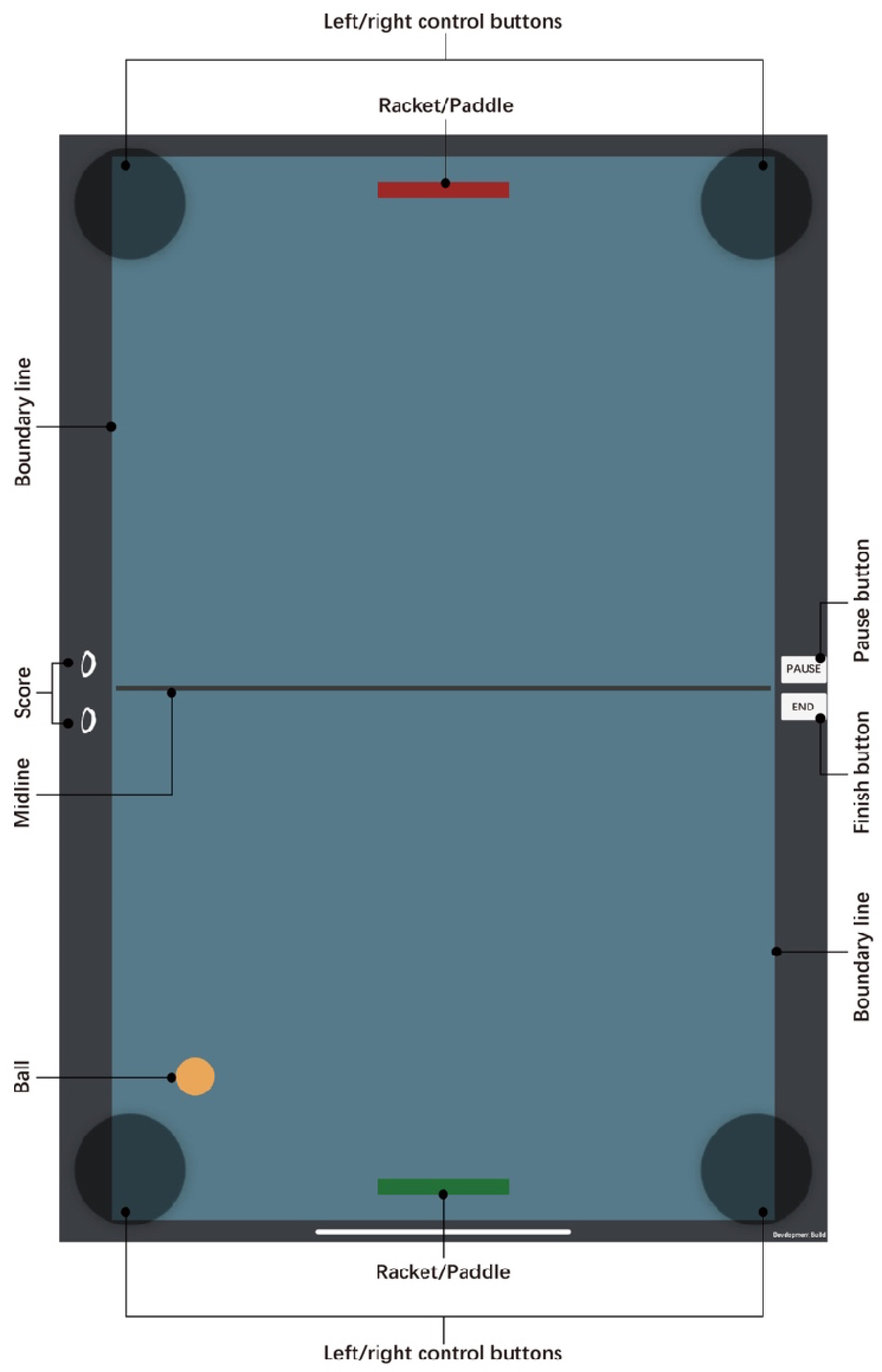


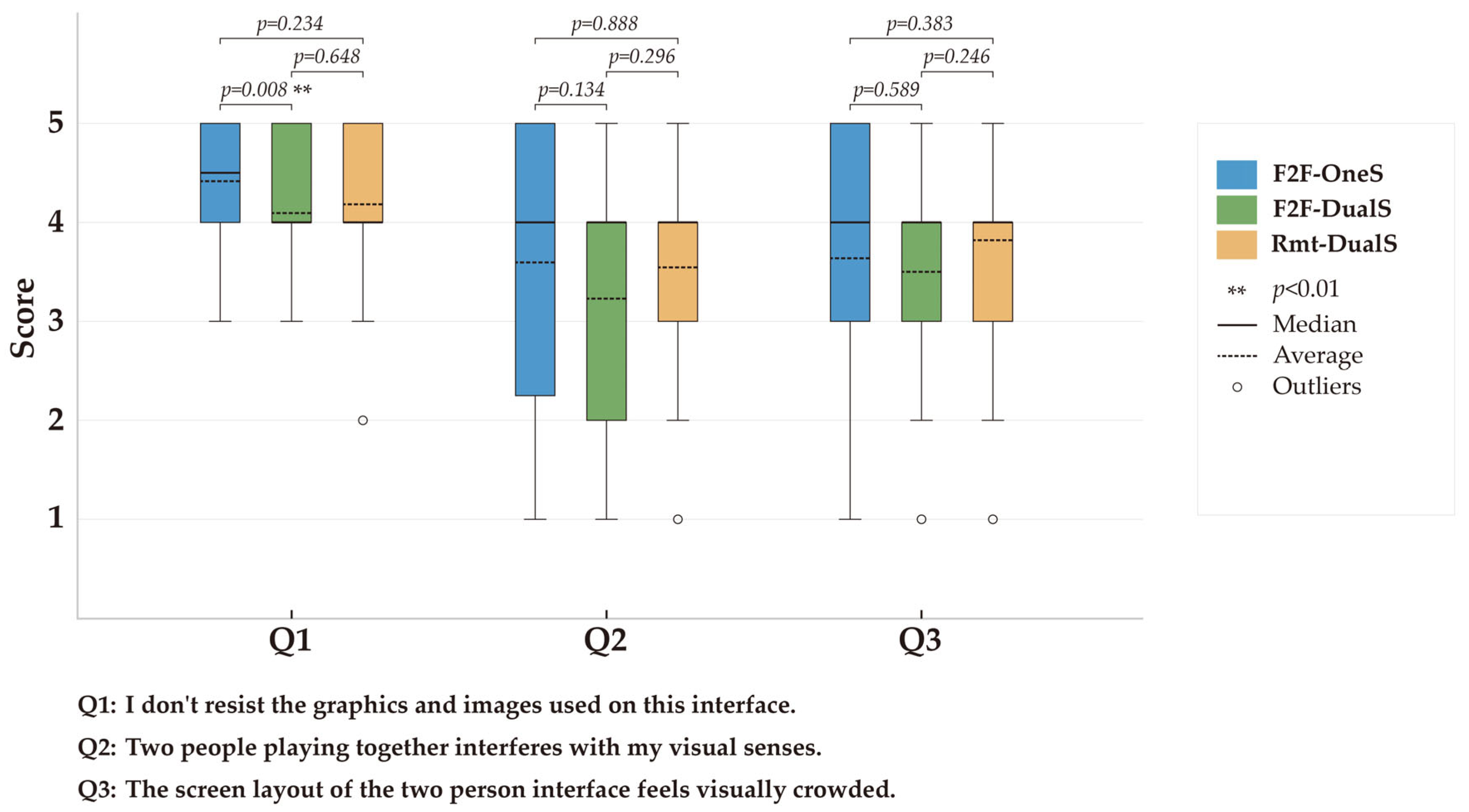

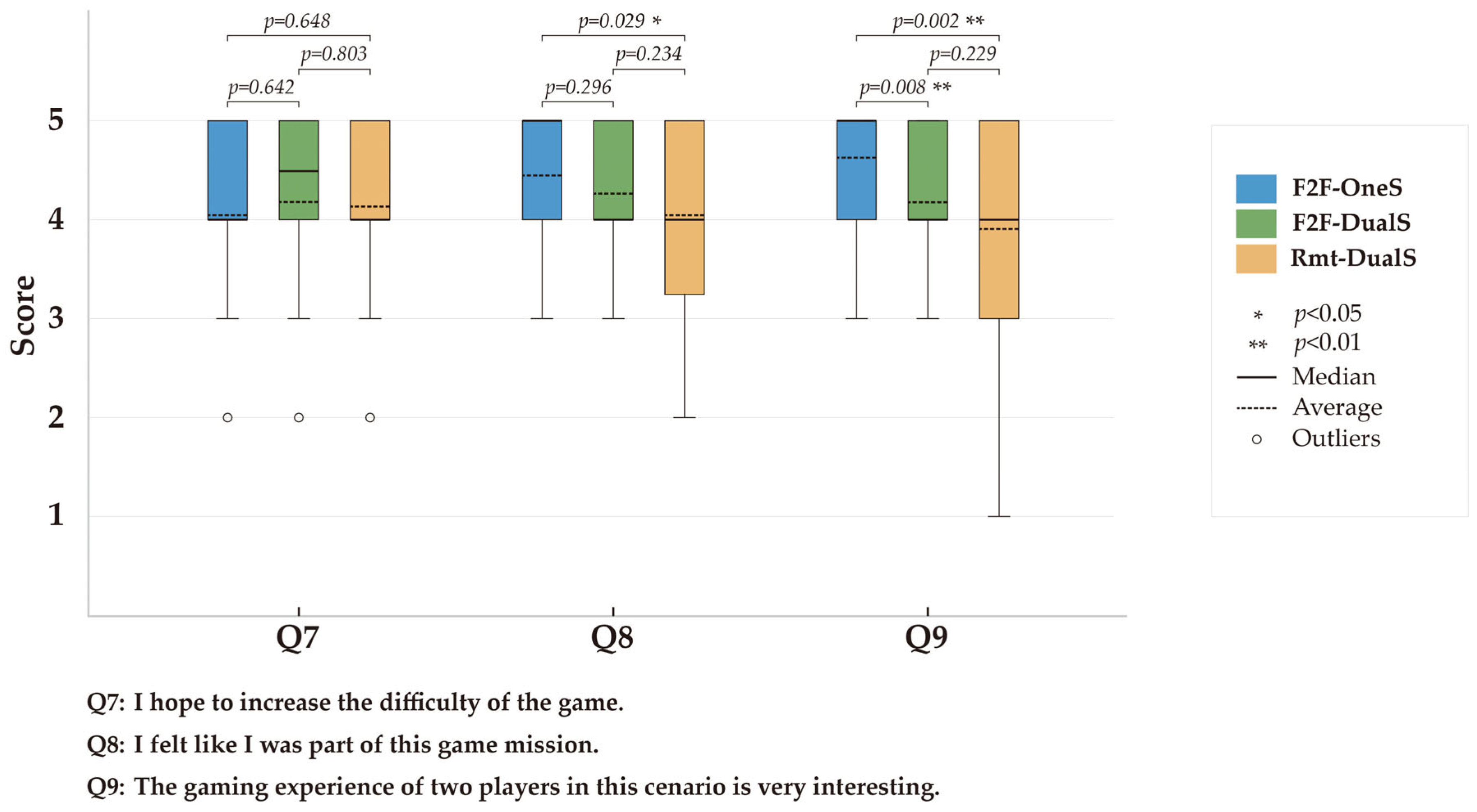
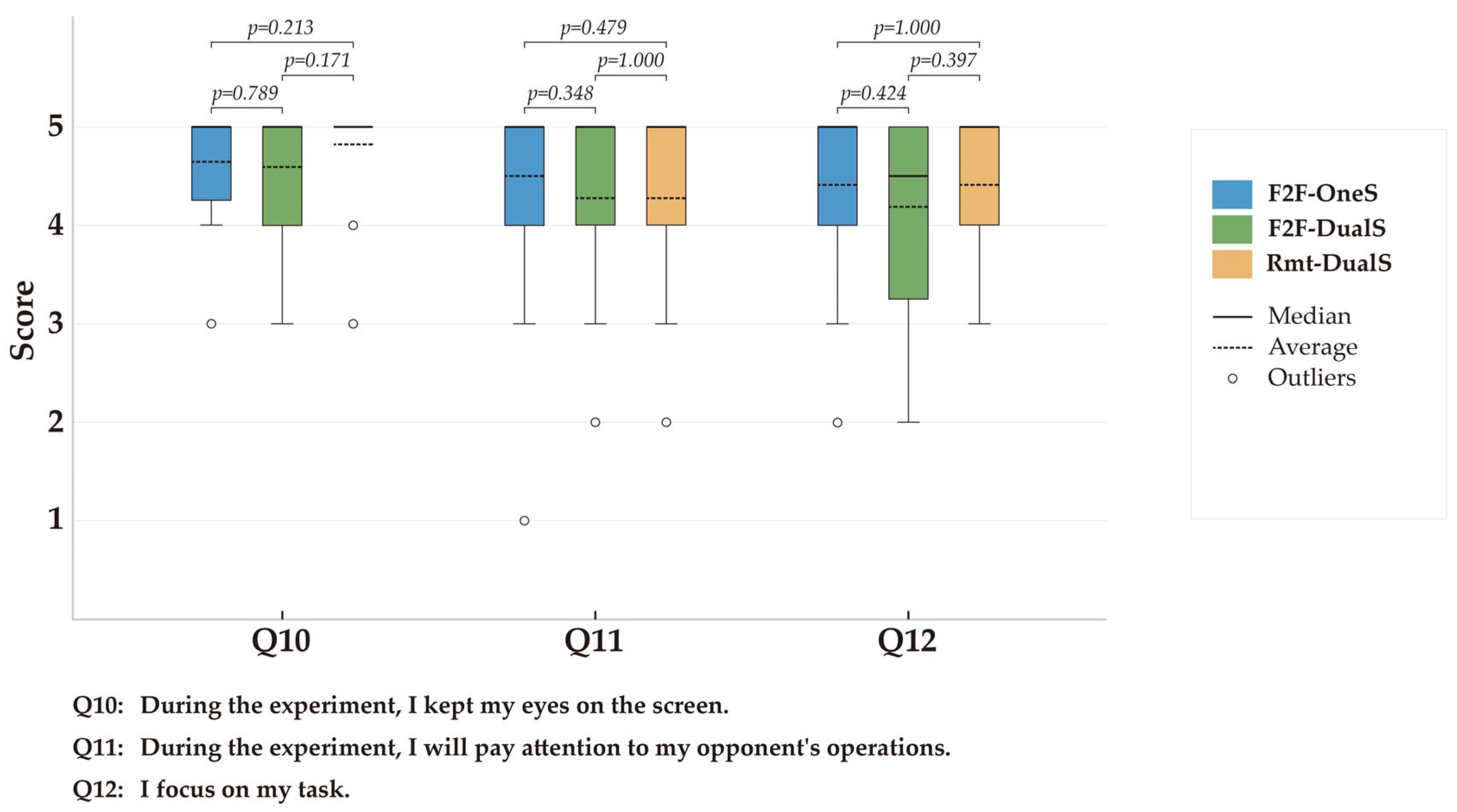


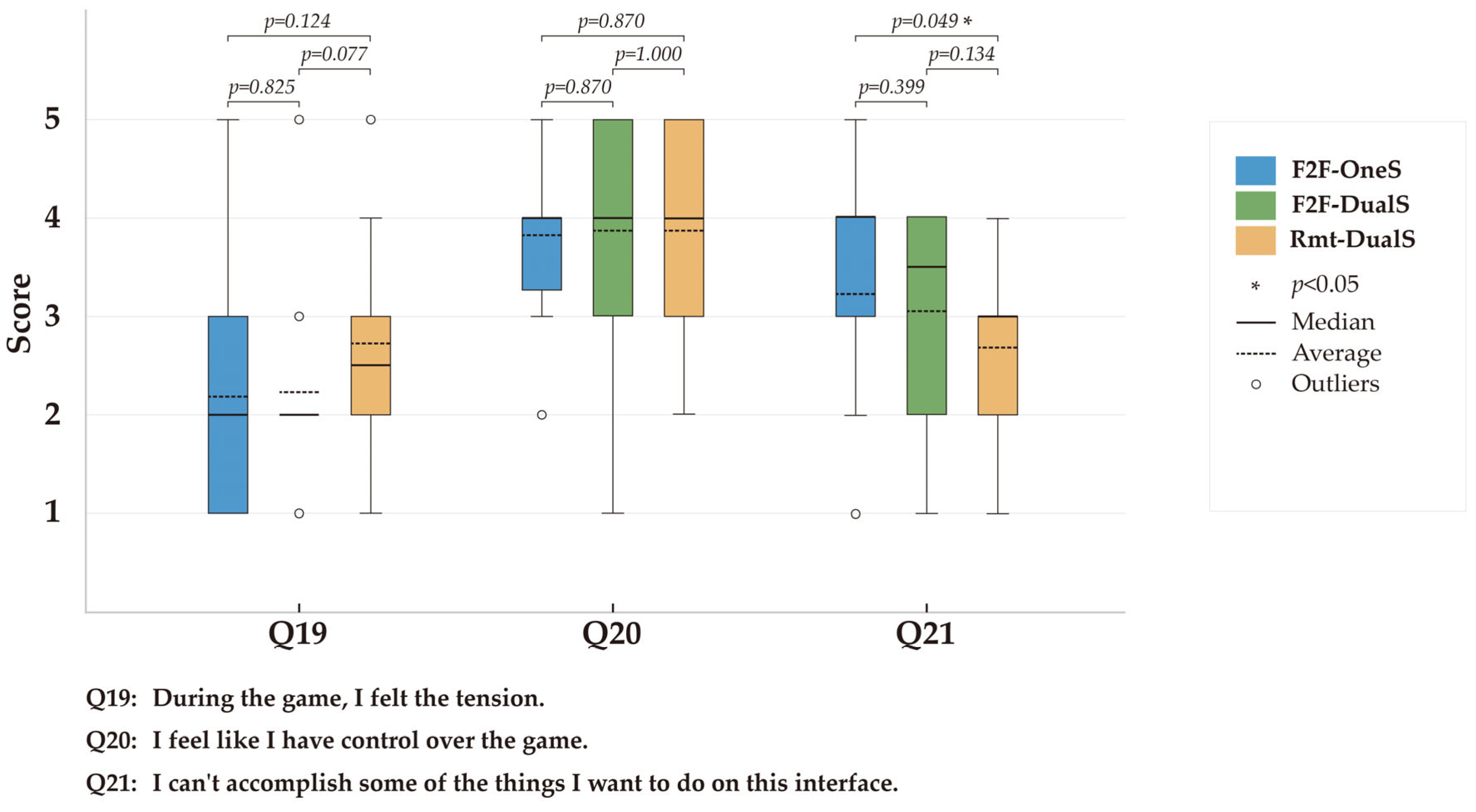
| Basic Info | Category | n | % |
|---|---|---|---|
| Gender | Male | 9 | 40.9 |
| Female | 13 | 59.1 | |
| Age | 18–25 | 13 | 59.1 |
| 26–30 | 5 | 22.7 | |
| 31–40 | 4 | 18.2 | |
| Pair type | Female–Female | 4 | 36.3 |
| Female–Male | 5 | 45.5 | |
| Male–Male | 2 | 18.2 |
| UX | No. | Questionnaire | Mean ± SD (n = 22) | p | Sig. | ||
|---|---|---|---|---|---|---|---|
| F2F-OneS | F2F-DualS | Rmt-DualS | |||||
| Visual Appearance | Q1 | I don’t resist the graphics and images used on this interface. | 4.41 ± 0.67 | 4.09 ± 0.75 | 4.18 ± 0.91 | 0.38 | ns |
| Q2 | Two people playing together interferes with my visual senses. | 2.41 ± 1.37 | 2.77 ± 1.45 | 2.45 ± 1.10 | 0.66 | ns | |
| Q3 | The screen layout of the two-person interface feels visually crowded. | 2.36 ± 1.26 | 2.50 ± 1.14 | 2.18 ± 0.96 | 0.7 | ns | |
| Durability | Q4 | I consider my gaming experience to be a success. | 4.45 ± 0.51 | 4.18 ± 0.80 | 3.41 ± 1.14 | 0 | ** |
| Q5 | This gaming experience did not go as I planned. | 2.50 ± 1.22 | 2.95 ± 1.21 | 2.68 ± 1.17 | 0.42 | ns | |
| Q6 | I think it’s more fun to play with friends and family rather than strangers. | 4.14 ± 1.13 | 3.86 ± 1.17 | 3.68 ± 1.09 | 0.36 | ns | |
| Sense of Participation | Q7 | I hope to increase the difficulty of the game. | 4.05 ± 1.00 | 4.18 ± 1.05 | 4.14 ± 0.89 | 0.79 | ns |
| Q8 | I felt like I was part of this game mission. | 4.45 ± 0.74 | 4.27 ± 0.70 | 4.05 ± 0.90 | 0.26 | ns | |
| Q9 | The gaming experience of two players in this scenario is very interesting. | 4.64 ± 0.58 | 4.18 ± 0.80 | 3.91 ± 1.02 | 0.02 | * | |
| Attention | Q10 | During the experiment, I kept my eyes on the screen. | 4.64 ± 0.66 | 4.59 ± 0.59 | 4.82 ± 0.50 | 0.27 | ns |
| Q11 | During the experiment, I will pay attention to my opponent’s operations. | 4.50 ± 0.91 | 4.27 ± 0.98 | 4.27 ± 1.08 | 0.71 | ns | |
| Q12 | I focus on my task. | 4.41 ± 0.80 | 4.18 ± 0.96 | 4.41 ± 0.80 | 0.69 | ns | |
| Q13 | In this gaming experience, I let myself go. | 3.59 ± 1.37 | 3.36 ± 1.29 | 3.18 ± 1.30 | 0.49 | ns | |
| Novelty | Q14 | Games can bring me a sense of novelty. | 4.09 ± 1.11 | 3.95 ± 1.05 | 3.27 ± 1.24 | 0.04 | * |
| Q15 | Opponents bring me novelty. | 4.23 ± 0.81 | 4.14 ± 0.89 | 3.50 ± 1.22 | 0.07 | ns | |
| Q16 | I'm interested in my game. | 4.00 ± 0.98 | 3.86 ± 1.04 | 3.64 ± 1.22 | 0.62 | ns | |
| Q17 | I am interested in my opponents. | 4.14 ± 0.89 | 4.05 ± 0.95 | 3.73 ± 0.94 | 0.29 | ns | |
| Perceived Usability | Q18 | I have difficulty using this interface. | 2.68 ± 1.04 | 3.00 ± 1.11 | 2.91 ± 1.23 | 0.67 | ns |
| Q19 | During the game, I felt the tension. | 3.82 ± 1.14 | 3.77 ± 1.07 | 3.27 ± 1.16 | 0.14 | ns | |
| Q20 | I feel like I have control over the game. | 3.82 ± 0.85 | 3.86 ± 1.08 | 3.86 ± 1.08 | 0.92 | ns | |
| Q21 | I can’t accomplish some of the things I want to do on this interface. | 2.68 ± 1.09 | 2.95 ± 1.13 | 3.32 ± 0.89 | 0.07 | ns | |
Disclaimer/Publisher’s Note: The statements, opinions and data contained in all publications are solely those of the individual author(s) and contributor(s) and not of MDPI and/or the editor(s). MDPI and/or the editor(s) disclaim responsibility for any injury to people or property resulting from any ideas, methods, instructions or products referred to in the content. |
© 2025 by the authors. Licensee MDPI, Basel, Switzerland. This article is an open access article distributed under the terms and conditions of the Creative Commons Attribution (CC BY) license (https://creativecommons.org/licenses/by/4.0/).
Share and Cite
Zhou, M.; Wang, J.; Kenta, O.; Watanabe, M.; Carlos, C.Q.J. Designing for Dyads: A Comparative User Experience Study of Remote and Face-to-Face Multi-User Interfaces. Electronics 2025, 14, 2806. https://doi.org/10.3390/electronics14142806
Zhou M, Wang J, Kenta O, Watanabe M, Carlos CQJ. Designing for Dyads: A Comparative User Experience Study of Remote and Face-to-Face Multi-User Interfaces. Electronics. 2025; 14(14):2806. https://doi.org/10.3390/electronics14142806
Chicago/Turabian StyleZhou, Mengcai, Jingxuan Wang, Ono Kenta, Makoto Watanabe, and Chacon Quintero Juan Carlos. 2025. "Designing for Dyads: A Comparative User Experience Study of Remote and Face-to-Face Multi-User Interfaces" Electronics 14, no. 14: 2806. https://doi.org/10.3390/electronics14142806
APA StyleZhou, M., Wang, J., Kenta, O., Watanabe, M., & Carlos, C. Q. J. (2025). Designing for Dyads: A Comparative User Experience Study of Remote and Face-to-Face Multi-User Interfaces. Electronics, 14(14), 2806. https://doi.org/10.3390/electronics14142806





